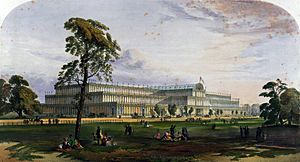Henry Cole facts for kids
Sir Henry Cole (born July 15, 1808 – died April 18, 1882) was an important British government worker and inventor. He helped create many new ideas in business and education during the 1800s in the United Kingdom. Henry Cole is famous for coming up with the idea of sending greeting cards at Christmas. He introduced the world's first commercial Christmas card in 1843.
Contents
Henry Cole's Early Life and Work

Henry Cole was born in Bath, Somerset. His father was Captain Henry Robert Cole. Young Henry went to a school called Christ's Hospital in 1817. After school, he started working as a clerk in 1823. He helped with old government records.
Even with his work, Henry Cole found time to study painting. He even showed his drawings at the Royal Academy of Arts. He became friends with famous people like John Stuart Mill. These friends often met to discuss ideas.
In 1838, a new office for public records was created. Henry Cole became one of the main assistants. He helped organize many old documents. He also pushed for a new building to store these important records. This led to the building in Fetter Lane, which started in 1851.
Helping with the Penny Post
Henry Cole was very busy. In 1838, he also became a secretary for a group that wanted to improve mail service. He helped create a newspaper called the Post Circular. He worked hard to get people to support postal reform.
From 1837 to 1840, he worked with Rowland Hill. Together, they played a big part in starting the Penny Post. This system allowed people to send letters for just one penny. Henry Cole is sometimes given credit for designing the world's first postage stamp, the Penny Black.
The First Christmas Card
In 1843, Henry Cole had a new idea. He asked an artist named John Callcott Horsley to create a special card. This card became the world's first commercial Christmas card. It was a new way for people to send holiday greetings.
Felix Summerly: A Creative Name
Henry Cole was also very interested in how things were designed. He used a secret name, Felix Summerly, for some of his creative projects. As Felix Summerly, he designed several items that were made and sold. One famous design was a teapot that won an award.
Under this name, he also wrote many children's books. Some of these books include The home treasury and Beauty and the beast. He also wrote a guide for Westminster Abbey and a book about animals called An Alphabet of Quadrupeds.
Henry Cole and Big Exhibitions
Henry Cole was a member of the Royal Society of Arts. He worked hard to convince the government to support better industrial design. He got the help of Prince Albert, Queen Victoria's husband.
In 1847, Cole organized a successful exhibition of art and manufactured goods. More large exhibitions followed in 1848 and 1849.
The Great Exhibition of 1851
Cole visited an exhibition in Paris in 1849. He noticed there wasn't a big exhibition open to countries from all over the world. He thought the Royal Society of Arts' planned exhibitions could become a huge international event.
He got the support of Queen Victoria. In 1850, a special group was formed to manage this new exhibition. Prince Albert was its leader.
The Great Exhibition of the Works of Industry of all Nations was held in the Crystal Palace in Hyde Park, London. It ran from May 1 to October 15, 1851. It was a huge success, both with visitors and financially. Henry Cole's smart management helped make it so successful.
Creating Museums and Art Schools

Henry Cole was one of the people who decided what to do with the money made from the Great Exhibition. They decided to use the £186,000 profit to improve science and art education in the UK.
Land was bought in South Kensington, London. This area became home to many educational and cultural places. People jokingly called it "Albertopolis" because Prince Albert was so involved.
Henry Cole became the first leader of the Department of Practical Art. This department was set up by the government to make art and design education better, especially for industry. He played a key role in developing the Victoria and Albert Museum. This museum started as the Museum of Ornamental Art. Cole oversaw its move to its current location. He became the first director of what was then called the South Kensington Museum from 1857 to 1873. Today, a part of the museum is named the Henry Cole Wing in his honor.
Honors and Lasting Impact
Henry Cole also helped create the National Art Training School, which later became the Royal College of Art. He was also involved in starting other important institutions in South Kensington, like the Royal College of Music and Imperial College London.
For his great work on the Great Exhibition, Cole received an award called the CB. In 1875, Queen Victoria made him a knight. He was often called "Old King Cole" in the newspapers. He had strong support from the Queen and especially from Prince Albert. Prince Albert once said, "We must have steam, get Cole," when he needed someone to make his projects happen.
A special blue plaque in London marks the house where Henry Cole lived and worked. It is at 33 Thurloe Square, right across from the Victoria and Albert Museum.
In 2001, one of Henry Cole's very first Christmas cards, sent to his grandmother in 1843, was sold at an auction for £22,500.
See also
 In Spanish: Henry Cole para niños
In Spanish: Henry Cole para niños



